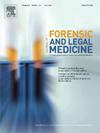Computational modeling of blunt force trauma to the atlanto-occipital joint: Implications for Forensic Pathology
IF 1.2
4区 医学
Q3 MEDICINE, LEGAL
引用次数: 0
Abstract
Background
The biomechanical response of the atlanto-occipital joint to blunt force trauma is an under-researched area in forensic pathology. This study investigates the joint's behavior under various impact scenarios using computational modeling, aiming to provide insights for enhancing postmortem examinations and injury analysis in forensic investigations.
Materials and methods
A computational model of the atlanto-occipital joint was developed, incorporating ligament properties, muscle forces, and equations of motion. Simulations were performed under 3000N and 5000N forces at 45°, with original and reduced damping conditions. Ligament tearing likelihood was assessed by comparing deformation to literature thresholds, and data were analyzed using Chi-square statistics and relative risk analysis.
Results
The study revealed that reduced damping significantly increased the vulnerability to tearing in the LAO and AAOL ligaments (p < 0.05), with the Barkow Ligament demonstrating an inherent susceptibility to traumatic disruption. Relative risk analysis showed that reducing damping had a higher risk of tearing compared to increasing force. The findings demonstrate that fatal joint damage can occur without excessive force or concurrent skeletal injuries.
Conclusion
This study provides a computational model for simulating the atlanto-occipital joint's response to blunt force trauma and introduces an innovative action table to guide postmortem examinations based on simulation results. The action table offers a systematic approach for forensic pathologists to examine injuries, identify patterns, assess forces, consider substance effects, and evaluate fatality risks and enhances the precision and reliability of forensic assessments in cases involving atlanto-occipital joint injuries.
寰枕关节钝力创伤的计算模型:对法医病理学的影响
背景寰枕关节对钝力创伤的生物力学反应在法医病理学中是一个研究不足的领域。本研究利用计算模型研究了关节在各种冲击情景下的行为,旨在为法医调查中加强尸检和损伤分析提供见解。材料和方法建立了寰枕关节的计算模型,包括韧带特性、肌肉力和运动方程。在初始和减小阻尼条件下,分别在45°方向3000N和5000N力下进行了仿真。通过比较变形与文献阈值来评估韧带撕裂的可能性,并采用卡方统计和相对风险分析对数据进行分析。结果研究表明,减少阻尼显著增加了LAO和AAOL韧带的撕裂易损性(p <;0.05), Barkow韧带表现出对创伤性断裂的固有易感性。相对风险分析表明,减少阻尼比增加力有更高的撕裂风险。研究结果表明,致命的关节损伤可以发生在没有过度的力量或并发骨骼损伤。结论本研究为模拟寰枕关节对钝力创伤的反应提供了一个计算模型,并根据模拟结果引入了一个创新的动作表来指导尸检。动作表为法医病理学家提供了一种系统的方法来检查损伤、识别模式、评估力、考虑物质效应和评估死亡风险,并提高了寰枕关节损伤案件法医评估的准确性和可靠性。
本文章由计算机程序翻译,如有差异,请以英文原文为准。
求助全文
约1分钟内获得全文
求助全文
来源期刊

Journal of forensic and legal medicine
MEDICINE, LEGAL-
CiteScore
2.70
自引率
6.70%
发文量
106
审稿时长
57 days
期刊介绍:
The Journal of Forensic and Legal Medicine publishes topical articles on aspects of forensic and legal medicine. Specifically the Journal supports research that explores the medical principles of care and forensic assessment of individuals, whether adult or child, in contact with the judicial system. It is a fully peer-review hybrid journal with a broad international perspective.
The Journal accepts submissions of original research, review articles, and pertinent case studies, editorials, and commentaries in relevant areas of Forensic and Legal Medicine, Context of Practice, and Education and Training.
The Journal adheres to strict publication ethical guidelines, and actively supports a culture of inclusive and representative publication.
 求助内容:
求助内容: 应助结果提醒方式:
应助结果提醒方式:


